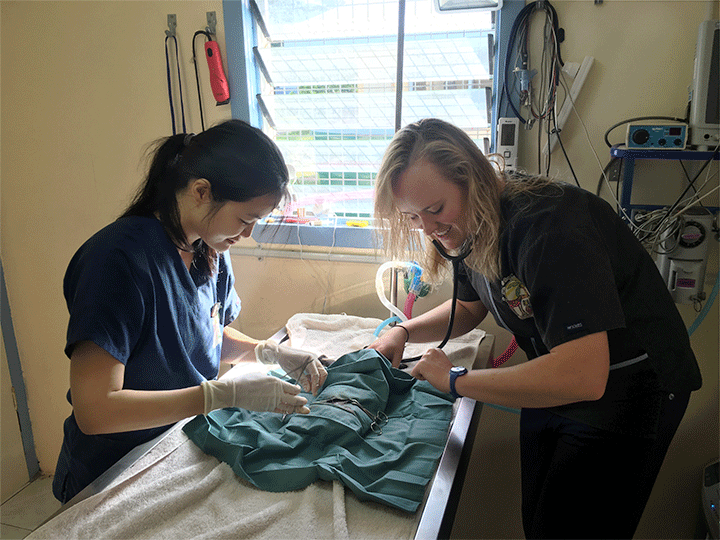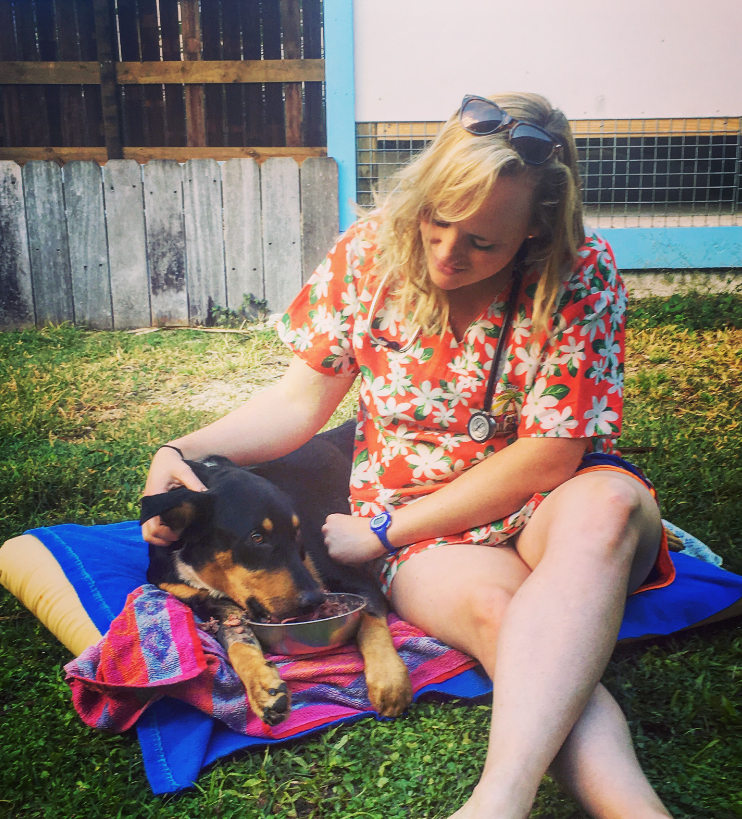Claire Stuhlmann - Rarotonga
Claire Stuhlmann - Rarotonga
Through funding from the Office for Global Programs, I had the incredible opportunity to travel to Rarotonga in the Cook Islands and spend my summer researching intestinal parasites and volunteering at the Te Are Manu Veterinary Clinic. Rarotonga is the largest of the fifteen islands that make up the Cook Islands nation and is home to over 14,000 people and estimates of 5,000 dogs. Te Are Manu is the only vet clinic in the entire country and is run entirely on donations and staffed by volunteer veterinarians from around the world. Animals from the neighboring islands are often flown to Rarotonga for treatment, and there is rarely a dull moment at the clinic. A few months before I flew to Rarotonga, Dr. Sean Owens and Dr. Jessica Sanchez from UC Davis spent a month at Te Are Manu establishing a small laboratory and building the capacity for a telepathology service so that volunteer veterinarians could consult with Dr. Owens, a clinical pathologist. With their mentorship and equipment, I was able to complete my own research project investigating the prevalence and distribution of intestinal parasites in dogs on Rarotonga. Though the clinic provides medication for clients to deworm their dogs, no research has been done to identify what parasites exist on the island and how prevalent they are in the canine population.
A preliminary review of my data suggests that the predominant intestinal parasite in dogs on Rarotonga is hookworm. Within my sample, hookworm had a 70-80% prevalence and there was no difference in prevalence between dogs that lived predominantly near the coast or those that lived inland near the jungle. Hookworm is a zoonotic parasite and people living in warm moist environments who come in contact with soil containing the infective larval stage have the greatest risk for infection (i.e. individuals walking around barefoot or children playing in the soil). Culturally, most dogs in Rarotonga are allowed to roam free and feces are rarely picked up. The tropical island climate is perfect for the eggs and larvae to survive in the soil, which increases the risk of transmission to humans. While doing this research, I worked closely with the community to teach them about hookworm and to educate dog owners on the importance of regular deworming treatment. My work was even featured in an article in the local newspaper, The Cook Island News.
In addition to research, I worked at the clinic alongside volunteer veterinarians from England, Scotland, India, Taiwan, and New Zealand. I practiced valuable skills including wound care and bandaging, taking and interpreting radiographs, triaging emergencies, monitoring anesthesia, and suturing. The veterinarians and I saw a variety of unique and fascinating cases including suspected tetanus toxicity, Ciguatera fish poisoning, and fibropapillomatosis in a sea turtle. One of the most valuable skills that I developed this summer and that will serve me throughout my career was client communication. To communicate effectively, I had to understand the different cultural beliefs and backgrounds that influenced my clients’ decisions and their understanding of disease processes and treatments. Advocating for my patients required recognizing and valuing these differences and creatively working with the local culture, not against it, to come up with solutions and treatments. To help with this, I spoke with a local woman who was a wealth of oral history and knowledge, especially regarding traditional medicines. I learned that papaya seeds were traditionally used to treat constipation and worms. By referencing the use of papaya seeds while explaining how to use deworming tablets, I connected more with my clients, and by showing respect for their medical beliefs, I gained their respect for my own. In another instance, while cleaning a large abscess on a dog’s neck that had ruptured, I found that the owner had packed the wound with plants. When I asked him what it was, he proudly replied that he had used cactus to treat the wound. Quickly suppressing my shock, I remembered that aloe is often referred to as cactus on Rarotonga and is used to treat skin conditions. After showing him the wound and talking about bacteria, infections, and antibiotics, he quickly agreed that antibiotics were a better course of treatment and gave me his remaining aloe supply to treat my very apparent sunburn.
This experience was an incredible opportunity to reinforce what I had learned during my first year in vet school, to further develop my skills, and to encourage my creativity in coming up with treatment plans given limited resources. The veterinarians that I worked with were incredible mentors and teachers, and I now have a family of vets around the world that I can turn to for advice and friendship. My time in Rarotonga at Te Are Manu was not without challenges and frustrations, including learning to drive a manual car while driving on the other side of the road, but every moment reminded me how lucky I am to be in the veterinary profession. I will never forget the warmth and appreciation of the community that welcomed me in Rarotonga and will always be grateful for this opportunity that was made possible by the Office For Global Programs, generous donors, Dr. Sean Owens, Dr. Jessica Sanchez, and the volunteers and clinic manager at Te Are Manu. Meitaki Maata (Thank you).


